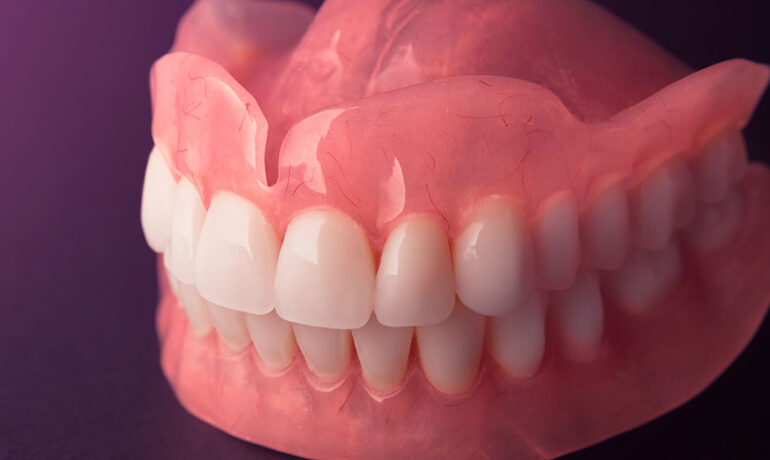Call 408-257-5950 • 19000 Cox Avenue, Suite A • Saratoga, CA 95070
Full or Partial Dentures: Understanding Your Options for a Better Smile

Undecided between complete or partial dentures? Let’s examine the advantages and disadvantages of each type side by side.
The primary difference lies in their purpose: complete (or full) dentures replace all your natural teeth, whereas partial dentures only replace some of them.
Complete Dentures
Before being fitted for dentures, all of your remaining natural teeth must be removed. This means you need to have a dental examination and tooth extraction. Your complete dentures come out when you sleep and should be brushed with specialized cleaning agents overnight to keep them from drying out.
Complete dentures not only look natural, but they also feel very comfortable. You suction them into place over your gums.
There are two types of dentures: “conventional” and “immediate.” A conventional denture is fitted after the teeth have been removed and the gum tissue has started to heal, which takes 8-12 weeks.
Immediate dentures are created before the procedure, as opposed to conventional dentures. This means they can be placed immediately after the teeth have been removed. Consequently, eight to twelve weeks do not have to pass without teeth for the patient. Remember that your bones and gums may shrink during the healing period following tooth removal, which can result in ill-fitting dentures. Therefore, denture adhesives should only be viewed as a temporary solution until the money is available for traditional dentures.
Partial Dentures
Partial dentures are designed to replace one or more teeth in a row. They look like complete dentures since they represent your gums and the missing tooth/teeth, but partial dentures are much smaller, so they can only fit where there is a gap between natural teeth. The partial denture has clasps on each side of the gaps, which attach to adjacent teeth.
A Partial Denture typically has replacement teeth connected by a metal framework to a plastic base, which is gum-colored or pink. It rests on your gums and is removable.
If some natural teeth remain in the upper or lower jaw, partial dentures are the best option. With this method, a dental bridge replaces one or more missing teeth by placing crowns on the surrounding teeth. The artificial tooth/teeth are then attached to them. This “bridge” is set in place with cement. A partial denture fills the gaps left by absent teeth and prevents other teeth from changing position. A precision partial denture is removable and has internal attachments instead of clasps that attach to surrounding crowns, giving it a more natural appearance.
Are There Alternatives to Dentures?
If you’re considering dental implants, you’re not alone – they are rapidly becoming popular for seniors. Implants can support cemented bridges and more closely resemble natural teeth than dentures. However, keep in mind that they also tend to cost more.
Dental implants may also provide more support for dentures. If you would like advice about dental implants, please consult your dentist.
How Are Dentures Made?
There are a few types of dentures that your dentist or prosthodontist can choose from for you, and the process usually takes a couple of weeks. Here’s what you can expect:
- Create a series of different expressions and note how your jaws move and the space between them.
- The first step in making a denture is to create an exact model of what the patient wants. You will use this mold multiple times and evaluate it each time for color, fit and comfort before creating the final product.
- Cast the final denture
- Adjustments will be made as necessary.
How do New Dentures Feel?
New dentures may initially feel uncomfortable as your cheeks and tongue get used to them. Also, you might experience minor irritation or soreness and increased saliva flow when wearing them – these are all common and should improve over time as your mouth adjusts.
Will Eating With New Dentures Be Difficult?
Getting used to eating with your new dentures will take some time, and you may feel discomfort for a few weeks. Begin by eating softer foods cut into small pieces to get accustomed to your new denture. Start chewing on both sides of your mouth evenly so you can get used to your new dentures. Once you’re more comfortable, add other foods to your diet until you return to eating normally. Be careful with hot or hard foods and sharp-edged bones or shells. Also, stay away from extremely sticky or hard foods. Finally, avoid chewing gum and using toothpicks while wearing dentures.
Are Dentures Worn 24 Hours a Day?
Your dentist or prosthodontist will tell you how long to wear your dentures after you receive them and when to take them out. For a few days, in the beginning, they must be worn all day and night. It may not feel comfortable at first, but this way, you can identify which areas of the denture need adjusting. Taking your dentures out before you go to sleep is best to give your gums a break. This also allows for regular stimulation and cleansing by the tongue and saliva. In the morning, you can put your denture back in place.
If you have healthy teeth remaining in your mouth, partial dentures may be your best option. However, complete dentures may be better if you’re missing several teeth. Deciding on a suitable denture can take time and effort. We will help you navigate your options and find the best denture. While dentures are a popular tooth replacement option, there are others available that we would be happy to discuss with you at your next appointment. Contact our office today for more information or to schedule an appointment!
